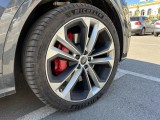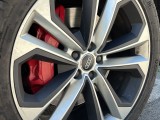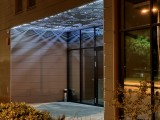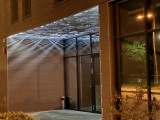Apple iPhone 14 Pro review

iPhone 13 Pro vs. iPhone 14 Pro shootout
We can't but do a shootout with the previous iPhone 13 Pro and see the improvements, or the lack of such, side by side.

Let's start with the main cameras. Looking through the photos side by side we see absolutely no difference as far as photo quality, colors and rendition are concerned.
The iPhone 14 Pro has a wider 24mm lens and because of that it offers wider field of view than the iPhone 13 Pro. And also because of the wider field of view, the extreme corners of the photos are a bit blurry.
Even with these tough to spot differences, for most purposes - the photos from the main cameras are identical.








iPhone 13 Pro main cam • iPhone 14 Pro main cam
We shot 2x digitally zoomed photos with both phones, but the iPhone 14 Pro with its 48MP sensor is far superior. It delivers near lossless photos with excellent detail, while the 13 Pro's cropped and upscaled ones offer halved detail and are plenty soft.








iPhone 13 Pro 2x zoom • iPhone 14 Pro 2x zoom
Both iPhones have identical 3x telephoto cameras and no wonder they deliver identical photos. Upon super close inspection, we found some of the iPhone 14 Pro photos to be a notch warmer than the 13 Pro's.








iPhone 13 Pro 3x tele • iPhone 14 Pro 3x tele
The photos from the main cameras at night taken with Auto Night Mode also appear to be identical, excluding the FoV difference.








iPhone 13 Pro main NM • iPhone 14 Pro main NM
The photos taken without Night Mode are not that different either. The center of the 14 Pro images looks a bit more detailed and sharper. Noise seems to be cleaned better on the 14 Pro, too.








iPhone 13 Pro main NM OFF • iPhone 14 Pro main NM OFF
Here is a surprise. While Apple uses a larger 12MP sensor for the ultrawide camera, it opted for a darker f/2.2 lens. And while this decision made for better macro photos, it has worsened the low-light ones even if not by much.
The ultrawide photos with Auto Night Mode from the iPhone 13 Pro have more saturated colors and sharper centers. We supposed they produce less noise because of the brighter lens, hence there is less noise to clean and a bit more detail is left after said cleaning.
Whole the difference isn't major, it sure is in favor of the older iPhone 13 Pro.








iPhone 13 Pro UW cam NM • iPhone 14 Pro UW cam NM
Without Night Mode, the iPhone 14 Pro saves slightly better photos with sharper centers. The difference is minor, sure, bit this time around it's in favor of the 14 Pro.








iPhone 13 Pro UW NM OFF • iPhone 14 Pro UW NM OFF
For the sake of this comparison, we also shot 2x zoomed samples. The iPhone 14 Pro offer a whole lot more detail and sharpness, because of the 48MP cropping.








iPhone 13 Pro 2x zoom • iPhone 14 Pro 2x zoom
The 3x telephoto cameras are identical on both iPhones and the photos we took at night with Auto Night mode are quite similar. The only notable difference worth mentioning is the slightly warmer colors on the iPhone 14 Pro model.








iPhone 13 Pro 3x tele • iPhone 14 Pro 3x tele
Video capturing
The iPhone 14 Pro can record video at up to 4K60 with all of its four cameras. 4K24 is also available across the board if you're after a more cinematic motion look. All videos are digitally (all four cams) stabilized and optically (all but ultrawide) - Apple calls this cinematic video stabilization. All modes, including the 4K60, feature expanded dynamic range thanks to the Smart HDR. The slow-mo options max out at 1080p at 240fps.
There is a new option called Enhanced stabilization, which is an enhancement over the default EIS and crops a bit more to deliver even more stabilized footage. We shot with and without this new option, and honestly, besides the small promised crop, we did not see any difference.
The new iPhone 14 Pro supports Cinematic mode (rack focus) now up to 4K at 30fps. HDR is also an option.
There is one new mode called Action mode. It's been on many other phones for years and it is intended to be shot at the ultrawide camera at 60fps. It crops heavily from the 4K footage (that's why the resolution is 2K) and delivers super smooth and incredibly stabilized video. It is available to all rear cameras and can be shot at any resolution and frame rate, but, as we pointed out, it's main hardware is the ultrawide camera at 2K@60fps.
And the action mode works just as promised delivering lovely 2K (2,816 x 1,584 px) 60fps videos with outstanding action-like stabilization and excellent smoothness. Detail, colors, contrast and dynamic range are praise-worthy, too.
We shot an action video with the primary camera, too, and while it yields the same quality of stabilization and picture, the narrower field of view makes it look a bit awkward.
You can capture HDR videos straight into the Dolby Vision format up to the same maximum 4K60 (the previous generation was limited to 30fps). You can edit these videos on the go on your phone, you can upload them on YouTube or any other popular platform, or even send them to your friends. The Dolby Vision information is saved outside of the video stream, so the video will look normal to any non-HDR player/screen and will be color-boosted on any Dolby Vision-compatible player and display.
You also have a choice between H.265 HEVC and H.264 video encoders. The High-Efficiency mode uses H.265 and is mandatory for 4K60 and HDR footage, while the More Compatible mode (H.264) provides easier playback across different devices.
The iPhone 14 Pro, just like the previous iPhones, capture wide stereo audio for the videos at about 192kbps.
The iPhones have been known for their class-leading video quality and the iPhone 14 Pro is no different. Even with the always-on electronic stabilization, which usually soften other videos, the iPhones still deliver outstanding video quality.
The main camera shoots magnificent 4K30 videos with a ton of resolved detail and natural rendition without any over-sharpening. There is no noise. The dynamic range is great and so is the contrast. The colors stay lively and true to life. If you decide to shoot in 24fps or 60fps - you will get the same quality, the videos will be just lower or larger in size because of the video bitrate difference.
The 2x zoomed video with the main camera are some of the best done this way - by cropping from the center and enhancing by machine learning. They have enough detail and satisfying rendition, while colors and contrast are as great as on the default video output.
We can notice some artificially-looking foliage and barely visible artifacts here and there, but we need to be really hard looking for them.
The telephoto camera is a close match to the primary one, btu zoomed. The rendition is natural, there is enough detail, and all other properties are excellent.
Finally, the 4K footage from the ultrawide camera is easily class-leading with exceptional detail levels, outstanding rendition and color presentation. The videos are noise-free, and with high contrast. There is also no visible distortion around the corners and yet the field of view remains incredibly wide.
The 4K videos from the selfie camera are superb with naturally defocused background due to the new f/1.9 aperture lens, and the autofocus capabilities, of course. The subject is sharp and well exposed, the colors are superb, and so is the contrast. The dynamic range is quite natural-looking, too.
Moving on to some low-light footage. The one from the main camera is great with plenty of resolved detail, natural sharpness, good exposure and low noise. The color saturation is superb, contrast is high and the dynamic is alright.
The 2x footage is soft as the noise reduction has taken a lot of the fine detail. It's still quite usable and offers good contrast and pliantly saturated colors.
The 3x nighttime zoomed videos are even softer than the 2x as they are often crops from the main camera, but otherwise with great colors and contrast. They are still usable, though far from great.
Finally, the 4K low-light video is pretty awesome all things considered. It has higher than expected resolved detail and good sharpness, probably because the gentler noise reduction. Everything is well exposed, the colors are saturated and realistic, and the contrast is kept high without hurting the good dynamic range. Overall, solid performance.
You can also look at our video compare tool and see how the iPhone 14 Pro stacks against other phones.



4K: Apple iPhone 14 Pro vs. Samsung Galaxy S22 Ultra and the Xiaomi 12S Ultra in our Video compare tool
Reader comments
- mood
- 14 Feb 2025
- Emn
🤡🤡🤡
- vurtuoso
- 25 Nov 2024
- h1g
2022... what a time huh?
- The King.
- 22 Aug 2024
- 84G
It's better. Miles better.